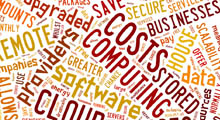In today’s digital world, most businesses rely on IT. Costs can include hardware and software, applications that require regular updates, internet access, maintenance, support, and training.
Large businesses are under pressure to improve performance, small to medium sized businesses want to compete on the world stage, and everyone wants to reduce overall IT costs and increase efficiency. As well as using TCO (total cost of ownership) to assess and manage the direct and indirect costs of IT, we have some suggestions for reducing your business costs today.
Cloud Servers
Cloud computing allows businesses to store large amounts of data and software on remote servers. The data stored remotely is secure and regularly backed up. Cloud computing reduces the need for in-house servers, and provides smaller companies with greater resources, scalability and capability.
Cloud computing can drastically reduce hardware costs. When you sign up with a cloud provider, you will only pay for the services you use and require. Many providers will offer software packages inclusive of the monthly cost. The software is normally upgraded free of charge, meaning that you can save on both licensing and upgrade costs.
As remote servers are maintained, you can save on running costs. This removes the in-house maintenance, and reduces the chance of downtime, whilst also reducing your energy costs.
Hosted Desktops
Hosted desktop technology provides users with the ability to access their desktop anywhere, at any time, from any device. More importantly, it is cost-effective.
Virtual desktops mean a reduction in hardware expenditure as data is stored remotely and there is no need to upgrade your existing hardware. You can also save on energy costs, as the cost of running your own servers and cooling systems will be removed.
Open Source Software
Open source software, or freeware, are programmes and software that are made and distributed collaboratively. These products are made available to the public free of charge. Examples of this software include OpenOffice, the freeware answer to Microsoft Office. It incorporates programs for word processing, spreadsheets and presentations.
Another popular piece of software is Inkscape, which has been created for designers. Inkscape is a vector graphics editor that has features similar to Illustrator. There is also GIMP, which is a graphics manipulation package, similar to PhotoShop, and Blender, a 3D computer graphics package.
If you are looking to decrease direct spend, as well as increasing productivity, it might be time to look into cloud services and begin using open source software to give your company free access to applications that would normally be expensive to purchase and upgrade.








